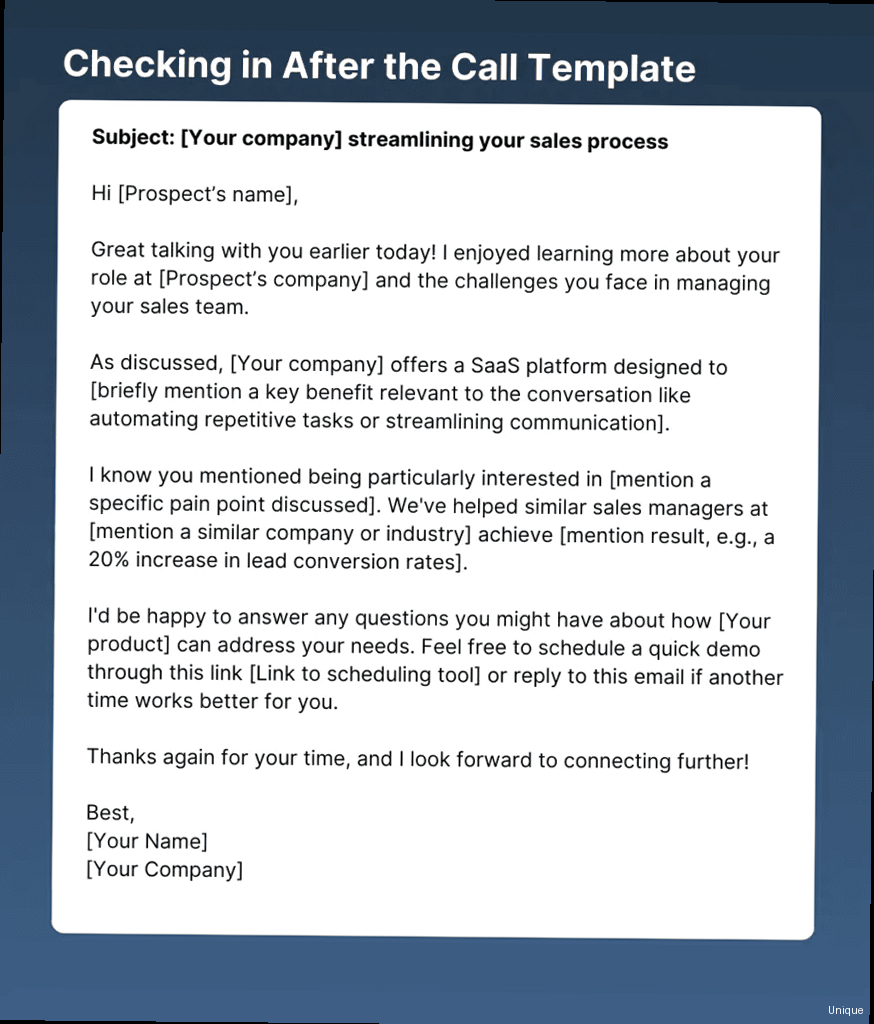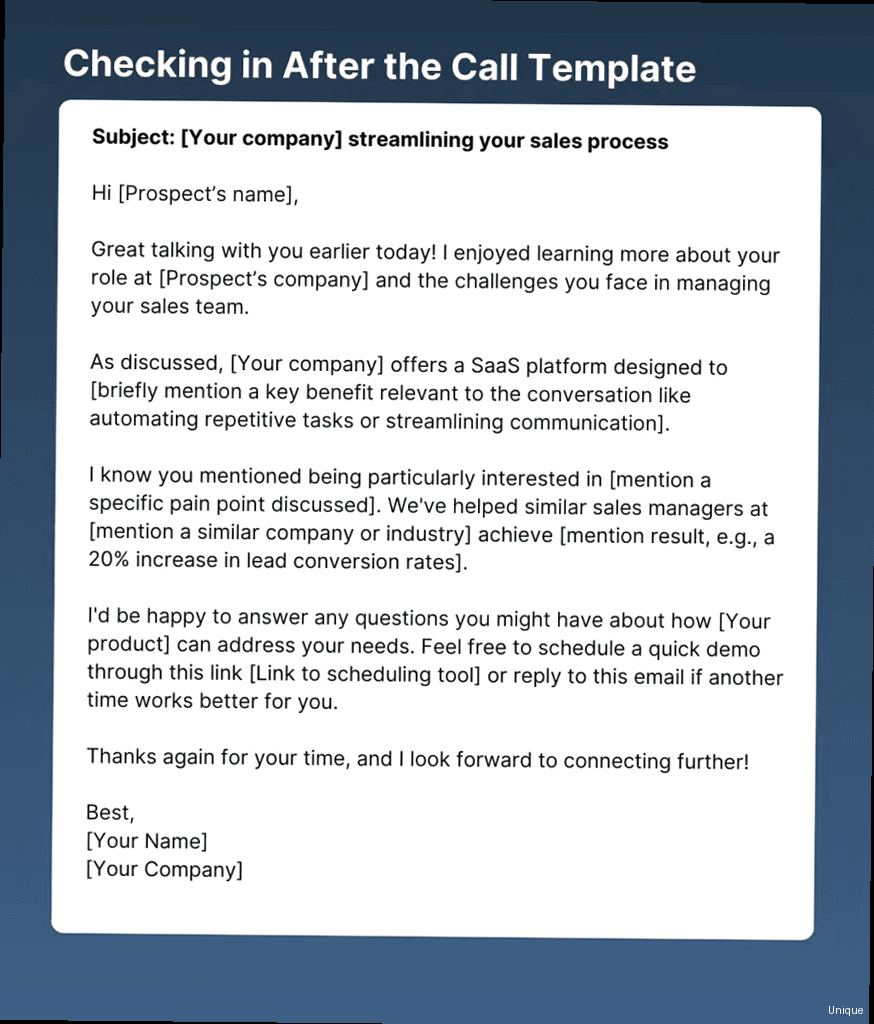How to Write a Follow-Up Email After a Cold Call
Landing a new client or making a sale often requires more than just a single cold call. The follow-up email is a crucial step in nurturing that initial contact and moving the conversation forward. This article will guide you through crafting effective follow-up emails that reinforce your value proposition, address potential concerns, and ultimately convert cold calls into warm leads.
Table of Contents:
- Reinforcing Your Value Proposition
- Personalizing the Message for Impact
- Crafting a Compelling Call to Action
- Optimizing Subject Lines for Higher Open Rates
- Tracking and Analyzing Email Performance
Reinforcing Your Value Proposition
 follow up email after a cold call - Example of an email clearly stating the value offered. Image should be of a mock email highlighting key benefits and showing metrics." title="Illustration for Example of an email clearly stating the value offered. Image should be of a mock email highlighting key benefits and showing metrics." width="512" height="512" / class="wp-image-183 wp-image-12400">
follow up email after a cold call - Example of an email clearly stating the value offered. Image should be of a mock email highlighting key benefits and showing metrics." title="Illustration for Example of an email clearly stating the value offered. Image should be of a mock email highlighting key benefits and showing metrics." width="512" height="512" / class="wp-image-183 wp-image-12400">The primary goal of your follow-up email is to reiterate the value you discussed during your initial cold call, but in a more concise and impactful way. It’s not enough to simply repeat what you said; you need to connect your solution to the prospect’s specific needs and pain points. Use this opportunity to showcase how you can solve their problems or improve their business outcomes. This section will cover how to effectively remind them of your offering and highlight the key differentiators that set you apart from the competition.
Highlighting Key Benefits
Instead of focusing on features, translate them into tangible benefits. What will the prospect gain by using your product or service? Increased efficiency? Reduced costs? Higher revenue? Quantify these benefits whenever possible to make them more compelling. For instance, instead of saying “Our software has advanced reporting capabilities,” say “Our software provides detailed reports that can help you reduce operational costs by 15% within the first quarter.”
Example:
Let’s say you sell CRM software. A poor follow-up might state: “Our CRM has excellent lead management and reporting features.” A better follow-up would say: “Our CRM software can help your sales team close deals 20% faster by automating lead nurturing and providing real-time sales insights, ultimately boosting your revenue.” This emphasizes the impact on their bottom line.
Addressing Potential Objections
Anticipate potential objections and address them proactively in your follow-up. Did the prospect express concerns about pricing, implementation, or integration? Acknowledge these concerns and offer solutions or reassurances. Demonstrating that you understand their reservations and are prepared to address them builds trust and credibility.
Example:
If the prospect mentioned concerns about the implementation process during the cold call, your follow-up email could include a statement like: “I understand your concerns about implementing a new CRM system. We offer comprehensive onboarding and training programs, as well as dedicated support to ensure a smooth transition for your team. We also integrate seamlessly with your existing accounting software, [Software Name].” This directly addresses their concern and provides a solution.
Sharing Relevant Resources
Provide valuable resources that support your value proposition. This could include case studies, white papers, blog posts, or product demos. Sharing relevant content positions you as a knowledgeable resource and provides the prospect with additional information to support their decision-making process. Ensure the resources are directly related to the prospect’s needs and pain points.
Example:
Continuing with the CRM example, include a link to a case study showcasing how your CRM software helped a similar company increase their sales. Your email could state: “I’ve attached a case study highlighting how [Company Name], a company similar to yours, increased their sales by 30% using our CRM software. I think you’ll find their experience insightful.” A link to a demo video would also be valuable. Make sure you provide a clear and concise description of what the resource contains.
Here is a small table summarizing how to effectively reinforce value in your follow-up email:
| Element | Description | Example |
|---|---|---|
| Highlight Key Benefits | Translate features into tangible advantages for the prospect. | “Reduce operational costs by 15%.” |
| Address Objections | Acknowledge concerns and offer solutions or reassurance. | “We offer comprehensive onboarding.” |
| Share Resources | Provide relevant case studies, white papers, or demos. | “Attached is a case study…” |
By clearly articulating the value you offer and addressing potential concerns, you increase the likelihood of the prospect engaging further with your sales process.
Personalizing the Message for Impact

Generic, impersonal emails are easily ignored. Personalization is key to capturing the prospect’s attention and demonstrating that you’ve taken the time to understand their specific needs. This goes beyond simply using their name; it involves referencing details from your initial conversation, researching their company, and tailoring your message to their industry and role. This section focuses on strategies for creating personalized follow-up emails that resonate with each individual prospect.
Referencing the Initial Conversation
Start by referencing something specific you discussed during the cold call. This immediately reminds the prospect of your conversation and demonstrates that you were actively listening. It also creates a sense of familiarity and rapport. Avoid vague statements like “It was great speaking with you.” Instead, mention a specific point you discussed, a question they asked, or a shared interest.
Example:
Instead of “It was great speaking with you,” try: “It was a pleasure discussing your challenges with managing your growing sales team. As we discussed, our CRM can help streamline your processes and improve team collaboration.” This immediately reminds them of the core issue you discussed and positions you as a solution provider.
Researching the Prospect and Their Company
Before sending your follow-up, take the time to research the prospect and their company. Visit their website, review their LinkedIn profile, and read recent news articles about their business. This research will provide valuable insights into their current challenges, goals, and priorities. Use this information to tailor your message and demonstrate that you understand their unique situation.
Example:
If you discover that the prospect’s company recently launched a new product, you could mention it in your follow-up email. For example: “Congratulations on the recent launch of [Product Name]! I noticed that you’re targeting the [Target Market] market. Our marketing automation platform can help you effectively reach and engage this audience.” This shows that you’re paying attention to their business and are genuinely interested in their success.
Tailoring the Message to Their Role and Industry
Different roles within a company have different priorities. Tailor your message to address the specific concerns and goals of the prospect’s role. For example, a CFO will be primarily concerned with cost savings and ROI, while a marketing manager will be more interested in lead generation and brand awareness. Similarly, tailor your message to the specific nuances of their industry.
Example:
If you’re contacting a CFO, focus on how your solution can reduce costs and improve efficiency. Your email could state: “As a CFO, you’re likely focused on optimizing operational costs. Our software can help you reduce IT expenses by 20% through automation and streamlined workflows.” If you are contacting a marketing manager, focus on how you can improve marketing campaigns, e.g. “I understand the challenges of generating qualified leads. Our platform can help you improve your lead generation and nurture strategies.”
By personalizing your follow-up emails, you demonstrate that you value the prospect’s time and are genuinely interested in helping them achieve their goals. This increases the likelihood of them engaging with your message and moving forward in the sales process.
Crafting a Compelling Call to Action
The call to action (CTA) is the most crucial part of your follow-up email. It tells the prospect what you want them to do next. A weak or unclear CTA can lead to inaction, even if the rest of your email is well-crafted. This section will explore how to create compelling CTAs that are specific, action-oriented, and easy to follow. The goal is to guide the prospect towards the next step in the sales process, whether it’s scheduling a demo, requesting a quote, or simply learning more about your offering.
Being Specific and Clear
Avoid vague CTAs like “Let me know if you’re interested.” Instead, be specific about what you want the prospect to do. Use action verbs that clearly communicate the desired action. For example, “Schedule a demo,” “Request a quote,” or “Download our white paper.” The more specific you are, the easier it is for the prospect to take the next step.
Example:
Instead of saying “Let me know if you want to learn more,” say: “Schedule a 15-minute call with me next week to discuss your specific needs and how our solution can help. You can book a time directly using this link: [Link to scheduling tool].” This provides a clear and easy way for the prospect to take the next step.
Offering Multiple Options
While it’s important to have a primary CTA, consider offering a few different options to cater to different preferences and levels of engagement. Some prospects may be ready to schedule a demo, while others may prefer to learn more by downloading a resource or reading a case study. Providing multiple options increases the likelihood of the prospect taking some form of action.
Example:
Your email could include the following CTAs: “Schedule a demo,” “Download our free e-book on [Relevant Topic],” and “View our customer case studies.” This gives the prospect a choice based on their current level of interest and readiness to engage.
Creating a Sense of Urgency
Adding a sense of urgency can motivate prospects to take action sooner rather than later. This can be achieved by offering a limited-time discount, a special promotion, or highlighting a limited availability. However, use urgency sparingly and ethically. Avoid creating false scarcity or misleading claims.
Example:
If you’re offering a limited-time discount, your CTA could state: “Schedule a demo this week and receive a 10% discount on your first year’s subscription.” If you have limited availability for demos, your CTA could state: “Schedule a demo now, as available slots are filling up quickly.”
A well-crafted CTA is the key to converting interest into action. By being specific, offering options, and creating a sense of urgency, you can significantly increase the effectiveness of your follow-up emails.
Optimizing Subject Lines for Higher Open Rates
Your subject line is the first (and often only) opportunity to grab the prospect’s attention. A compelling subject line can entice them to open your email, while a weak or generic subject line can lead to immediate deletion. This section will provide strategies for crafting effective subject lines that increase open rates and encourage prospects to engage with your message. It’s crucial to remember that your subject line should accurately reflect the content of your email and avoid being misleading or clickbait-y.
Personalization in the Subject Line
Just as personalization is important in the body of your email, it can also be effective in your subject line. Using the prospect’s name, company name, or referencing a specific topic discussed during the cold call can significantly increase open rates. However, use personalization judiciously and avoid overusing it, as it can sometimes come across as insincere or spammy.
Example:
Instead of a generic subject line like “Following Up,” try: “[Prospect Name], following up on our conversation about CRM solutions” or “Quick question about [Prospect’s Company] and [Relevant Topic].” This immediately grabs their attention and reminds them of your previous interaction.
Creating a Sense of Curiosity
Intrigue the prospect by creating a sense of curiosity in your subject line. Tease a key benefit, ask a thought-provoking question, or hint at a solution to their problem. The goal is to pique their interest and make them want to learn more by opening your email. However, ensure that your email delivers on the promise made in the subject line.
Example:
Instead of “Follow Up Regarding Our Conversation,” try: “Unlock [Key Benefit] for [Prospect’s Company]” or “Are you making this common mistake with your [Relevant Area]?” These subject lines create curiosity and encourage the prospect to open the email to find out more.
Using Action-Oriented Language
Use strong action verbs in your subject line to encourage immediate action. Words like “Discover,” “Learn,” “Get,” and “Improve” can be highly effective in grabbing the prospect’s attention and motivating them to open your email. These verbs suggest that the email contains valuable information or an opportunity they won’t want to miss.
Example:
Instead of “Inquiry Follow-Up,” try: “Discover how to improve your [Relevant Metric] by 20%” or “Learn how to reduce your [Pain Point] with our solution.” These subject lines are action-oriented and clearly communicate the value proposition of your email.
Expert Tip: Keep your subject lines concise and to the point. Shorter subject lines are more likely to be fully visible on mobile devices, which are increasingly used for email access.
Optimizing your subject lines is an ongoing process. Experiment with different approaches and track your results to see what works best for your target audience. A/B testing different subject lines is a great way to identify the most effective strategies for increasing open rates.
Tracking and Analyzing Email Performance
Sending follow-up emails is only half the battle. To truly optimize your cold calling and follow-up strategy, you need to track and analyze the performance of your emails. This section will cover the key metrics to monitor, how to track them, and how to use the data to improve your future campaigns. Without tracking, you are working in the dark.
Key Metrics to Monitor
Several key metrics can provide valuable insights into the effectiveness of your follow-up emails. These include:
- Open Rate: The percentage of recipients who opened your email. This metric indicates the effectiveness of your subject line.
- Click-Through Rate (CTR): The percentage of recipients who clicked on a link in your email. This metric measures the engagement level and the effectiveness of your call to action.
- Bounce Rate: The percentage of emails that could not be delivered. High bounce rates can indicate outdated or invalid email addresses.
- Conversion Rate: The percentage of recipients who completed the desired action, such as scheduling a demo or requesting a quote. This is the ultimate measure of your email’s success.
Example:
Let’s say you send 100 follow-up emails. If 20 recipients open the email, your open rate is 20%. If 5 recipients click on a link in the email, your CTR is 5%. If 2 emails bounce, your bounce rate is 2%. And if 1 recipient schedules a demo, your conversion rate is 1%. Tracking these rates over time can help you gauge effectiveness.
Tools for Tracking Email Performance
Several tools can help you track and analyze your email performance. These include:
- Email Marketing Platforms: Platforms like Mailchimp, HubSpot, and Constant Contact offer built-in tracking and analytics features.
- CRM Systems: Many CRM systems, such as Salesforce and Zoho CRM, also provide email tracking capabilities.
- Email Tracking Software: Specialized email tracking software, such as Yesware and SalesLoft, offers advanced features for tracking individual emails and analyzing overall campaign performance.
These tools allow you to track open rates, click-through rates, bounce rates, and conversion rates, as well as provide insights into which subject lines and calls to action are most effective.
Using Data to Improve Future Campaigns
The data you collect from tracking your email performance is invaluable for improving your future campaigns. Analyze your results to identify trends and patterns. Which subject lines generated the highest open rates? Which calls to action resulted in the most conversions? Use these insights to refine your messaging, targeting, and overall strategy.
Example:
If you notice that subject lines with personalized names have a higher open rate, incorporate personalization more frequently in your future campaigns. If you find that a particular call to action is not performing well, try experimenting with different wording or placement. Continuously testing and optimizing your emails based on data is the key to maximizing your results.
Quote: “What gets measured, gets managed.” – Peter Drucker. This quote emphasizes the importance of tracking and analyzing your efforts to improve performance.
By tracking and analyzing your email performance, you can gain valuable insights into what works and what doesn’t. This allows you to continuously improve your cold calling and follow-up strategy and ultimately achieve better results.
